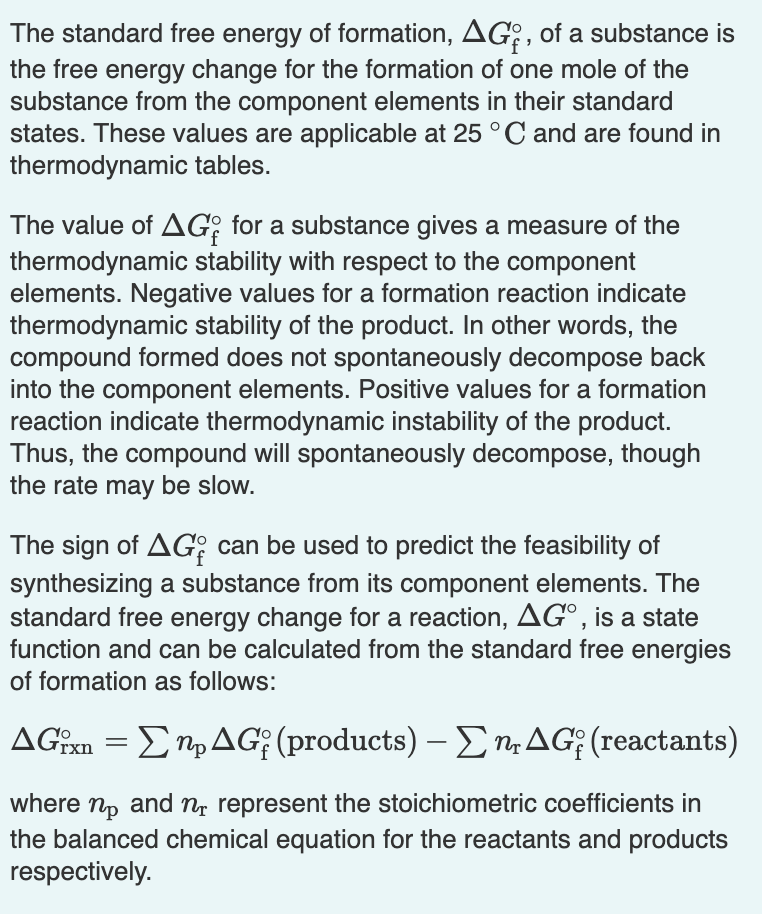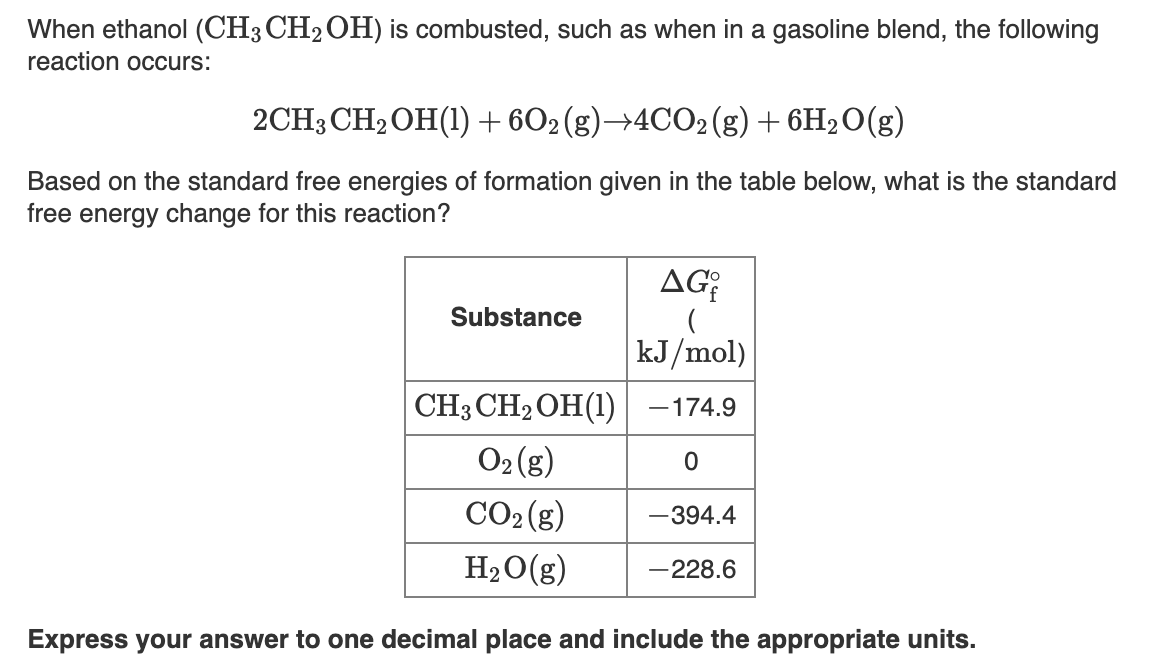2CH3CH2OH(1) + 602(g)—4CО2(в) + 6H20(g) Based on the standard free energies of formation given in the table below, what is the standard ree energy change for this reaction? AG Substance kJ/mol) |СHз CH2ОH(1)| — 174.9
2CH3CH2OH(1) + 602(g)—4CО2(в) + 6H20(g) Based on the standard free energies of formation given in the table below, what is the standard ree energy change for this reaction? AG Substance kJ/mol) |СHз CH2ОH(1)| — 174.9
Principles of Modern Chemistry
8th Edition
ISBN:9781305079113
Author:David W. Oxtoby, H. Pat Gillis, Laurie J. Butler
Publisher:David W. Oxtoby, H. Pat Gillis, Laurie J. Butler
Chapter14: Chemical Equilibrium
Section: Chapter Questions
Problem 108CP
Related questions
Question

Transcribed Image Text:The standard free energy of formation, AG: , of a substance is
the free energy change for the formation of one mole of the
substance from the component elements in their standard
states. These values are applicable at 25°C and are found in
thermodynamic tables.
The value of AG; for a substance gives a measure of the
thermodynamic stability with respect to the component
elements. Negative values for a formation reaction indicate
thermodynamic stability of the product. In other words, the
compound formed does not spontaneously decompose back
into the component elements. Positive values for a formation
reaction indicate thermodynamic instability of the product.
Thus, the compound will spontaneously decompose, though
the rate may be slow.
The sign of AG: can be used to predict the feasibility of
synthesizing a substance from its component elements. The
standard free energy change for a reaction, AG°, is a state
function and can be calculated from the standard free energies
of formation as follows:
ΔG Ση, AG; (products) -Ση ΔG; (reactants)
where np and n, represent the stoichiometric coefficients in
the balanced chemical equation for the reactants and products
respectively.

Transcribed Image Text:When ethanol (CH3CH2OH) is combusted, such as when in a gasoline blend, the following
reaction occurs:
2CH3CH2OH(1) + 602(g)—4CО2 (8) + 6H20(g)
Based on the standard free energies of formation given in the table below, what is the standard
free energy change for this reaction?
AG
Substance
kJ/mol)
CH3 CH2 OH(1) –174.9
O2 (g)
CO2 (g)
-394.4
H2O(g)
-228.6
Express your answer to one decimal place and include the appropriate units.
Expert Solution
This question has been solved!
Explore an expertly crafted, step-by-step solution for a thorough understanding of key concepts.
This is a popular solution!
Trending now
This is a popular solution!
Step by step
Solved in 2 steps

Knowledge Booster
Learn more about
Need a deep-dive on the concept behind this application? Look no further. Learn more about this topic, chemistry and related others by exploring similar questions and additional content below.Recommended textbooks for you

Principles of Modern Chemistry
Chemistry
ISBN:
9781305079113
Author:
David W. Oxtoby, H. Pat Gillis, Laurie J. Butler
Publisher:
Cengage Learning

Chemistry: The Molecular Science
Chemistry
ISBN:
9781285199047
Author:
John W. Moore, Conrad L. Stanitski
Publisher:
Cengage Learning


Principles of Modern Chemistry
Chemistry
ISBN:
9781305079113
Author:
David W. Oxtoby, H. Pat Gillis, Laurie J. Butler
Publisher:
Cengage Learning

Chemistry: The Molecular Science
Chemistry
ISBN:
9781285199047
Author:
John W. Moore, Conrad L. Stanitski
Publisher:
Cengage Learning


Chemistry: An Atoms First Approach
Chemistry
ISBN:
9781305079243
Author:
Steven S. Zumdahl, Susan A. Zumdahl
Publisher:
Cengage Learning

Chemistry
Chemistry
ISBN:
9781305957404
Author:
Steven S. Zumdahl, Susan A. Zumdahl, Donald J. DeCoste
Publisher:
Cengage Learning

Chemistry: Principles and Practice
Chemistry
ISBN:
9780534420123
Author:
Daniel L. Reger, Scott R. Goode, David W. Ball, Edward Mercer
Publisher:
Cengage Learning